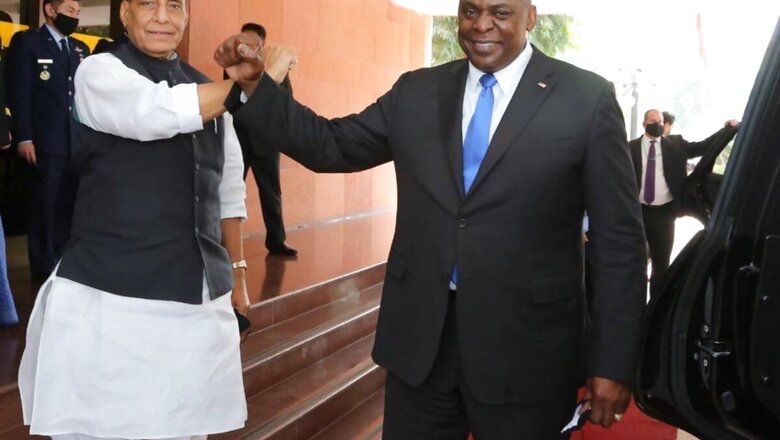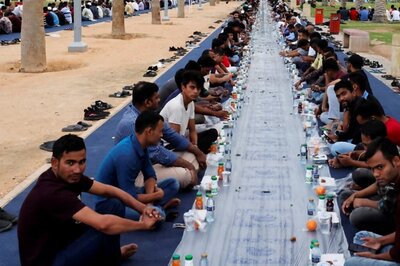
views
US defence secretary Lloyd Austin arrived in India on March 19, early in the Joe Biden presidency, to take forward the US-India defence and security relations given a fillip by this month’s summit of the Quadrilateral Security Dialogue, dubbed the Quad. Senator Bob Menendez, chairman of the Senate Foreign Affairs Committee, reminded him to also take up their concerns about human rights abuses and declining democratic norms in India. The other issue of equal concern to the United States is the continuing defence cooperation between India and Russia.
The Indian side denied that India’s human rights record was discussed, dissimulating that in fact the issue only came up in the context of concerns of minorities in Afghanistan in a post US troop withdrawal scenario. Secretary Austin in his media interaction insisted that “conversations” did occur on US concerns about India’s worsening record at home. But clearly it was not a stumbling block to bilateral relations: the US is using it more to satisfy congressional concerns and employ it as a lever to press New Delhi on the other issue, i.e., Russian defence sales to India.
The US desire to rope-in India is driven by its China balancing strategy. In that sense, the Biden administration is merely continuing, albeit more smartly, Donald Trump’s China policy, involving rallying of select democracies of the Indo-Pacific by the revival of the four-nation Quad, consisting of Australia, India, Japan and the US, in 2017. The grouping was born a decade earlier in 2007, when President George W Bush was in office. Meanwhile, US-Russia relations have incrementally worsened since Russia’s intervention in Ukraine in 2014. Democrats felt that Russia had played a role via social media and direct interference to tilt the 2016 US presidential election in favour of Donald Trump. Although Trump maintained a tough stance on Russia, he never directly blamed Russian president Vladimir Putin or named him as a mastermind in various suspected cyber-attacks on US corporate and national security agencies. President Biden assumed office convinced of Russian interference in US electoral affairs.
In 2017, the US Congress had passed the Countering America’s Adversaries Through Sanctions Act (CAATSA). Then defence secretary Jim Mattis failed to get mitigating clauses added to enable the US administration to allow exemptions. So, as the law stands, it is difficult to apply it selectively, particularly as US-Russian relations have only worsened after President Biden took charge, especially his agreeing with a questioner that Russian president Putin is a “killer”. The US is also seeing growing convergence between Russia and China, complicating US containment of what is seen as errant behaviour of both. Some analysts opine that US-Russian relations may be the worst they have been since the fall of the Berlin Wall in 1989. Former defence secretary Robert Gates feels that sanctions against Russia “are not going to do much good”, as it now has China to trade with.
What is being thus called the new Cold War has China at its centre, with Russia as a supporting actor in countering the US. But the motivations of the two differ. While Putin is the great disruptor, China wants to compete and dominate the next generation of technologies in telecommunications and artificial intelligence, besides controlling rule-making of existing and new regimes at a multilateral level. From the US perspective, the 2+2 meeting at Alaska between the foreign ministers and NSAs of the United States and China was to convey US readiness to take up the Chinese challenge in technological competition.
Into this new maze India is thrust, having its own differentiated strategic motivation. India-Russia relations may not be as warm as they were during the Cold War, but New Delhi realises that Russia is important for India to maintain a balanced foreign policy. India would not like Russia to move fully into the China-Pakistan corner for various reasons. One is its ability to produce and sell weapons that give value for money and often involve technology transfer. Also India cannot switch from its hybrid defence equipment mix to US dominated supplies overnight. Russia is also an important player in West Asia and Iran. It has carved out influence in Afghanistan, as shown by it hosting a meeting of different Afghan stakeholders even before they undertook US suggested intra-Afghan dialogue in Turkey. Despite a Chinese Central Asian push, using the Belt and Road Initiative, Russian and Indian interests converge in ensuring that Russia retains its foothold in its former territory. India-Iran-Russia have since the Vajpayee government two decades ago had a rudimentary North-South transit corridor mechanism. With Chabahar operational, early sanctions relief for Iran would be in the interest of India, Russia, Central Asia and Afghanistan.
Endangering the India-US bonhomie is the announced purchase by India of the $5.5 billion S-400 Russian air defence system. Turkey’s purchase of the same caused a major spat with fellow NATO ally US, which cancelled Turkish access to F-35 planes. Although sanctions imposed by Trump in December 2020 fell only on the Turkish institution that manages the defence industry, similar sanctions can stall Indian purchase of 30 weaponised drones that can multiply New Delhi’s capabilities to monitor and punish, on land and sea. The Chinese would dread these sentinels, able to stay aloft for 48 hours, to follow Chinese ships and submarines as they exit the Malacca Straits.
This new dilemma inverts the challenge India faced fifty years ago when Pakistan began a genocide in East Pakistan. The Soviets became quasi-allies after the Indo-Soviet treaty of Peace, Friendship and Cooperation was signed in August 1971. Unknown to India, Pakistan had won over US President Richard Nixon and his Secretary of State Henry Kissinger by arranging the latter’s secret visit to Beijing in July 1971. The US continued to ignore the massacre of Bengalis, graphically portrayed in the book The Blood Telegram, as the larger game of weaning away China was underway. Today, India is on the side of US to counter China while attempting to retain the goodwill of Russia.
Between CAATSA, a domestic democratic decline in India, mounting US-Russia tensions over a cyberwar and Russian interference in electoral processes in Western democracies and a Chinese ‘wolf warrior’ syndrome, Indian diplomacy will be tested. Hopefully the US realises that, whatever the nature of government in Delhi, India shall be a friend but never an ally.
Read all the Latest News, Breaking News and Coronavirus News here




















Comments
0 comment